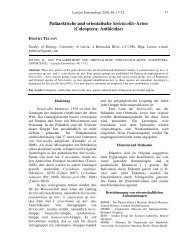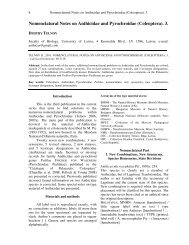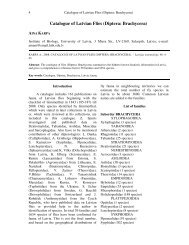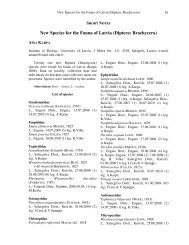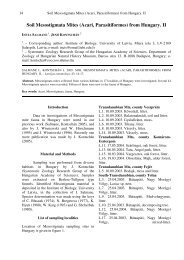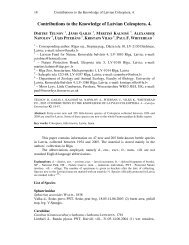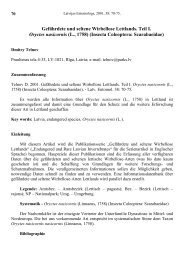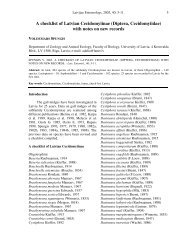First record of Phaneroptera falcata (PODA, 1761) (Orthoptera ...
First record of Phaneroptera falcata (PODA, 1761) (Orthoptera ...
First record of Phaneroptera falcata (PODA, 1761) (Orthoptera ...
You also want an ePaper? Increase the reach of your titles
YUMPU automatically turns print PDFs into web optimized ePapers that Google loves.
Latvijas Entomologs 2012, 51: 155-157. 155<br />
short note<br />
<strong>First</strong> <strong>record</strong> <strong>of</strong> <strong>Phaneroptera</strong> <strong>falcata</strong> (PoDa, <strong>1761</strong>)<br />
(<strong>Orthoptera</strong>, Phaneropteridae) in Latvia<br />
kristaPs sokolovskis 1 , Jānis suveizda 2<br />
1 – Institute <strong>of</strong> Systematic biology, Daugavpils University, Vienības iela 13,<br />
LV-5401, Daugavpils, Latvia; e-mail: kristaps.sokolovskis@gmail.com<br />
2 – Špoģi secondary school, Daugavpils novads, Višķu pagasts, Šosejas iela 3,<br />
LV-5481, Špoģi, Latvia; e-mail: joonc@inbox.lv<br />
Species <strong>of</strong> the genus<br />
<strong>Phaneroptera</strong> (sErviLLE, 1831) are<br />
long-winged thermophilous bushcrickets<br />
(Kočárek et al. 2008),<br />
widespread in the old World and<br />
Australia (Tauber et al. 2001). The<br />
phytophilous / arbusticolous and<br />
very mobile (capable <strong>of</strong> flying)<br />
bush-cricket (Fartmann et al. 2008)<br />
P. <strong>falcata</strong> is Euro-Siberian species,<br />
distributed from France and Belgium<br />
to Japan (Kočárek et al. 2008). In<br />
Asiatic part <strong>of</strong> Russia North border<br />
<strong>of</strong> P. <strong>falcata</strong> distribution area goes<br />
between 51° and 51,40°N (Böhme et<br />
al. 2011). In Ukraine, N-border line is<br />
not clearly known but possibly runs<br />
between 52° and 53°N. The northern<br />
borderline <strong>of</strong> distribution area through<br />
Belarus and the European part <strong>of</strong><br />
the Russian Federation needs more<br />
faunistic research efforts (Böhme et<br />
al. 2011).<br />
<strong>Phaneroptera</strong> <strong>falcata</strong> is <strong>record</strong>ed<br />
for the first time in Latvia: Daugavpils<br />
County, Ambeļi parish (56°01’27”N/<br />
26°51’44”E). Jānis Suveizda in<br />
24.08.2011 observed approximately<br />
20 individuals. Bush-crickets were<br />
photographed in natural environment<br />
(Fig. 1) and 2 specimens (1♂, 1♀,<br />
leg. J. Suveizda) collected for precise<br />
determination (det. K. Sokolovskis).<br />
The examined material is deposited<br />
in the collection <strong>of</strong> Institute <strong>of</strong><br />
Systematic Biology <strong>of</strong> Daugavpils<br />
University.<br />
The habitat where new <strong>record</strong> was<br />
made was covered with ruderal plant<br />
community, where dominant species<br />
were: Cirsium arvense, Echinochloa<br />
crusgalli and Galinsoga parviflora.<br />
From dendr<strong>of</strong>lora some Betula<br />
pendula, Alnus glutinosa and Salix<br />
sp. were present as well. Previous<br />
studies show that species occupy a
156<br />
<strong>First</strong> <strong>record</strong> <strong>of</strong> <strong>Phaneroptera</strong> <strong>falcata</strong> (Poda, <strong>1761</strong>) in Latvia<br />
wide variety <strong>of</strong> open habitats, from<br />
xerothermic vegetation to wetlands,<br />
including ruderal habitats in towns,<br />
but it demands taller herbaceous<br />
or shrubby vegetation (or trees)<br />
(Kočárek et al. 2008). P. <strong>falcata</strong> is<br />
not restricted to one orthopteran<br />
community and occur in both natural<br />
and semi-natural habitats (Fartmann<br />
et al. 2008).<br />
In adjacent territories,<br />
<strong>Phaneroptera</strong> <strong>falcata</strong> has been<br />
already reported from South Lithuania<br />
(Ivanskas, Rimšaitė 2008) but is not<br />
yet known from Belarus (Böhme et<br />
al. 2011). No data are available about<br />
findings in Estonia.<br />
The expansion <strong>of</strong> P. <strong>falcata</strong> to<br />
the north has been noticed in several<br />
countries <strong>of</strong> Western Europe. This<br />
eurytopic species is able to quickly<br />
colonize new sites (Kočárek et<br />
al. 2008). Unlike many species <strong>of</strong><br />
bush-crickets whose eggs must pass<br />
through two winters before hatching,<br />
P. <strong>falcata</strong> eggs mature after one winter<br />
(Ivanskas, Rimšaitė 2008). This<br />
means that current territory should<br />
be monitored next July-August to<br />
find out whether the eggs survive the<br />
winter successfully.<br />
Acknowledgements<br />
Special thanks to Maksims<br />
Balalaikins (Daugavpils University,<br />
Latvia) for consultations.<br />
References<br />
Böhme W., Geissler P., Wagner P.<br />
2011. A remarkable <strong>record</strong> <strong>of</strong><br />
<strong>Phaneroptera</strong> <strong>falcata</strong><br />
(poda, <strong>1761</strong>) (Saltatoria:<br />
Phaneropteridae) from northeastern<br />
Poland. – Bonn<br />
Zoological Bulletin 60, No. 1:<br />
109-111.<br />
Tauber E., Cohen D., Greenfield<br />
M.D., Pener M.P. 2001. Duet<br />
singing and female choice in the<br />
Bushcricket <strong>Phaneroptera</strong> nana.<br />
– Behaviour 138, No. 4: 411-430.<br />
Kočárek P., holuša J., Vlk R.,<br />
Marhoul P., Zuna-Kratky T.<br />
2008. Recent expansions <strong>of</strong><br />
bush-crickets <strong>Phaneroptera</strong><br />
<strong>falcata</strong> and <strong>Phaneroptera</strong> nana<br />
(orthoptera: Tettigoniidae) in the<br />
Czech Republic. – Articulata 23,<br />
No. 1: 67-75.<br />
Ivanskis P., Rimšaitė J. 2008.<br />
<strong>Phaneroptera</strong> <strong>falcata</strong><br />
(poda, <strong>1761</strong>) (orthoptera,<br />
Phaneropteridae) in Lithuania. –<br />
Acta zoologica lituanica 18, No.<br />
4: 270-272.<br />
Fartmann T., Behrens M., Loritz h.<br />
2008. orthopteran communities<br />
in the conifer-broadleaved<br />
woodland zone <strong>of</strong> the Russian<br />
Far East. – European Journal <strong>of</strong><br />
Entomology 105: 673-680.<br />
Received: February 3, 2012.
Latvijas Entomologs 2012, 51: 155-157. 157<br />
Figure 1. Female specimen <strong>of</strong> <strong>Phaneroptera</strong> <strong>falcata</strong> (poda, <strong>1761</strong>) from<br />
SE Latvia, Ambeļi parish (photo I. Suveizda).



